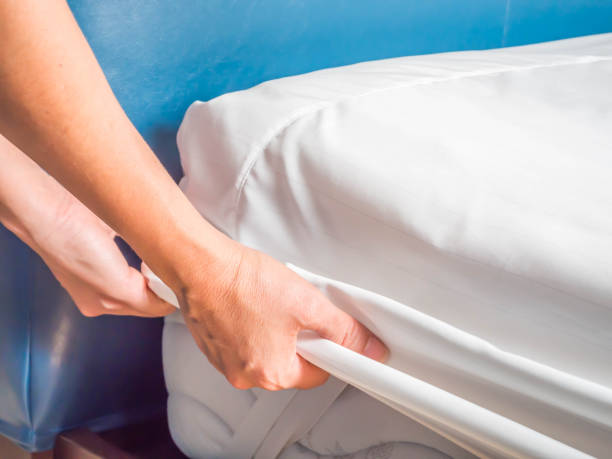
While bed bugs are not known to build nests for their young, they are notorious for living next to their hosts. If this means sharing the bed with the host, it means sharing the bed with the host. Bed bugs will do just about anything to avoid detection, access a blood meal, and find a suitable host. In the meantime, it is your responsibility to deter these insects from sharing your living quarters. One deterrence is called a “mattress cover,” which is exactly as its name entails. A mattress cover adds a layer of protection between your mattress and live bed bugs. Bed Bug Exterminator Indianapolis
What To Look For In A Bed Bug Mattress Cover
Just the remote possibility of sharing a bed with bed bugs is enough to make the hair on the back of your neck stand up straight. With the right mattress cover, it may be possible to keep these insects at bay. While this will not completely avoid a bed bug infestation, it will help lower the risk significantly. An exposed mattress is an open invitation to bed bugs. With so many mattress protectors on the market, you may become confused by the time you need to make a decision.
To maximize your bed bug risk, it is best to invest in a brand that covers the entire mattress from top to bottom. This will not only protect the mattress top but also the bottom and sides. Learn more about bed bug mattress protectors by reading the content provided in the article below.
What You Need To Know First
First and foremost, you need to know the ins and outs of a mattress protector. This protection is designed to partially or fully protect mattresses from all kinds of exposure, including bed bugs. If you are looking for full protection, your best option will be a mattress slip, which will encase your entire mattress. These are available with a zipper or Velcro closure to secure the mattress inside the cover. The zipper design will be your best option because it will fully seal off all potential bed bug access points. If for some reason, the Velcro is not completely sealed, it will leave openings for bed bugs to access your mattress. While mattress covers are designed to keep bed bugs at bay, they also prove helpful in bed bug eradication.
How To Choose The Perfect Mattress Cover?
You cannot go wrong with any mattress cover brand, as some form of protection is better than no protection at all.
Full Encasement – Is This My Best Option?
As mentioned previously, a full mattress encasement will offer full protection against bed bugs. You simply slip it over one end of your mattress, pulling it down until it is fully covered. Seal the enclosure and never worry about bed bugs invading your mattress ever again.
How Do I Know If My Mattress Cover Is Sealed Properly?
Inspect the cover to determine if it leaves your mattress exposed to bed bugs. If the enclosure does not seal properly, it will leave access points open for bed bugs. While these insects may appear harmless, they are parasites that feed on human blood. If the zipper or other closure malfunctions, it may be time to consider a new, improved replacement. Do not take any risks because your mattress plays a major role in your sleep cycle.
Do Manufacturers Test Their Mattress Covers?
Most manufacturers do test their mattress protectors because they want to be able to legally offer 100% bed bug protection. Instead of just telling consumers their mattress cover fights against bed bug infestations, they want to be able to prove it.
Mattress Covers – Are They Made From Toxic Materials?
Some brands do utilize chemical bed bug deterrence for their mattress covers. These anti-bed bug deterrence products are effective in staving off bed bug infestations. But, they may pose some health risks to people with respiratory illnesses, such as asthma and COPD, as well as chemical allergies. We recommend fully washing the mattress cover before installing it. This will remove most of the chemicals while protecting their integrity, so they are still effective.
Is The Bed Bug Mattress Encasement Effective?
Most certainly, as this is what they are specifically designed to do. However, not all mattress encasement products are created equal. Some are lacking full protection against bed bug infestations. The problem is most often related to the actual closure, such as a zipper, ties, and Velcro. In this case, the main purpose of a mattress encasement is to deter bed bugs from accessing your mattress. With this said, mattress encasement products are not effective in eradicating full-blown bed bug infestations. If you install them after your mattress is determined to be infested with bed bugs, the only thing it may do is trap a couple of insects.
Bed bugs are nocturnal invaders and feeders. They spend their days hiding in discrete locations and nights foraging for human or animal blood. Even if you have never been concerned about a bed bug infestation, a mattress encasement may be a good investment. It can extend the life of your mattress by protecting it from element exposure. Contact our local Indianapolis, Indiana office to schedule an appointment with our extermination company. We offer appointment-only in-home inspections free of charge. If you want to get down to business, we can offer you a free quote via email, landline, or snail mail. We can help you customize a bed bug infestation eradication/prevention strategy that is guaranteed to offer full protection.

